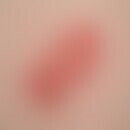Synonym(s)
HistoryThis section has been translated automatically.
DefinitionThis section has been translated automatically.
Rare genodermatosis with primary manifestation on palmae and plantae and later dissemination, initially assigned to porokeratoses based on histologic features (evidence of a plume-like parakeratosis).
You might also be interested in
EtiopathogenesisThis section has been translated automatically.
Autosomal dominant mutation in the MVD gene (Jägle S et al.2021). The mutated gene is located on chromosome 17q24 (Stevens HP et al.1996).
LocalizationThis section has been translated automatically.
ClinicThis section has been translated automatically.
Symmetrically distributed, approximately 0.2-0.4 cm large keratotic papules with a tendency to polycyclic confluence.
HistologyThis section has been translated automatically.
Differential diagnosisThis section has been translated automatically.
External therapyThis section has been translated automatically.
The treatment of the horny papules is carried out with keratolytic externals, e.g. with 2-5% salicylic acid (Salicylvaseline Lichtenstein, R228, R227 ), 5-10% urea, 3% NaCl R105 or 5% lactic acid R108.
In pressure-exposed areas, surgical procedure if necessary, either by curettage or laser treatment (Erbium-YAG or CO2 laser).
Internal therapy with acitretin is not very promising according to our own experience.
Internal therapyThis section has been translated automatically.
Progression/forecastThis section has been translated automatically.
LiteratureThis section has been translated automatically.
- Brasch J et al (1985) Porokeratosis plantaris, palmaris et disseminata. Dermatologist 36: 459-461
- Cast SB, Osbourn RA, Lutzner MA (1971) Porokeratosis plantaris, palmaris, et disseminata: a third type of porokeratosis. Arch Derm 104: 366-373
- Itin PH (1995) Porokeratosis plantaris, palmaris et disseminata with multiple filiform hyperkeratosis and nail dystrophy. dermatologist 46: 896-872
- Lanka P et al (2015) Punctate Porokeratosis Palmaris et Plantaris.Indian J Dermatol 60:284-286.
- Shaw JC et al (1984) Porokeratosis plantaris palmaris et disseminata. J Am Acad Dermatol 11: 454-460
- Wei SC et al (2003) Identification of a locus for porokeratosis palmaris et plantaris disseminata to a 6.9-cM region at chromosomes 12q24.1-24.2 Br J Dermatol 149: 261-267
Incoming links (7)
Arsenic keratoses; Punctate palmoplantar keratoderma; Salicylic acid ointment 1/2/3/5/10 or 20% (nrf 11.43.); Salicylic acid ointment (w/o); Spiny keratoderma of the palms and soles; Urea 10%/lactic acid 5% cream (nfa) (o/w); Urea 10%/salt 3% ointment (w/o);Outgoing links (14)
Acanthosis; Acitretin; Genodermatoses; Lactic acid; Papel; Porokeratoses (overview); Porokeratosis mibelli; Porokeratosis superficialis disseminata actinica; Salicylic acid; Salicylic acid ointment 1/2/3/5/10 or 20% (nrf 11.43.); ... Show allDisclaimer
Please ask your physician for a reliable diagnosis. This website is only meant as a reference.





